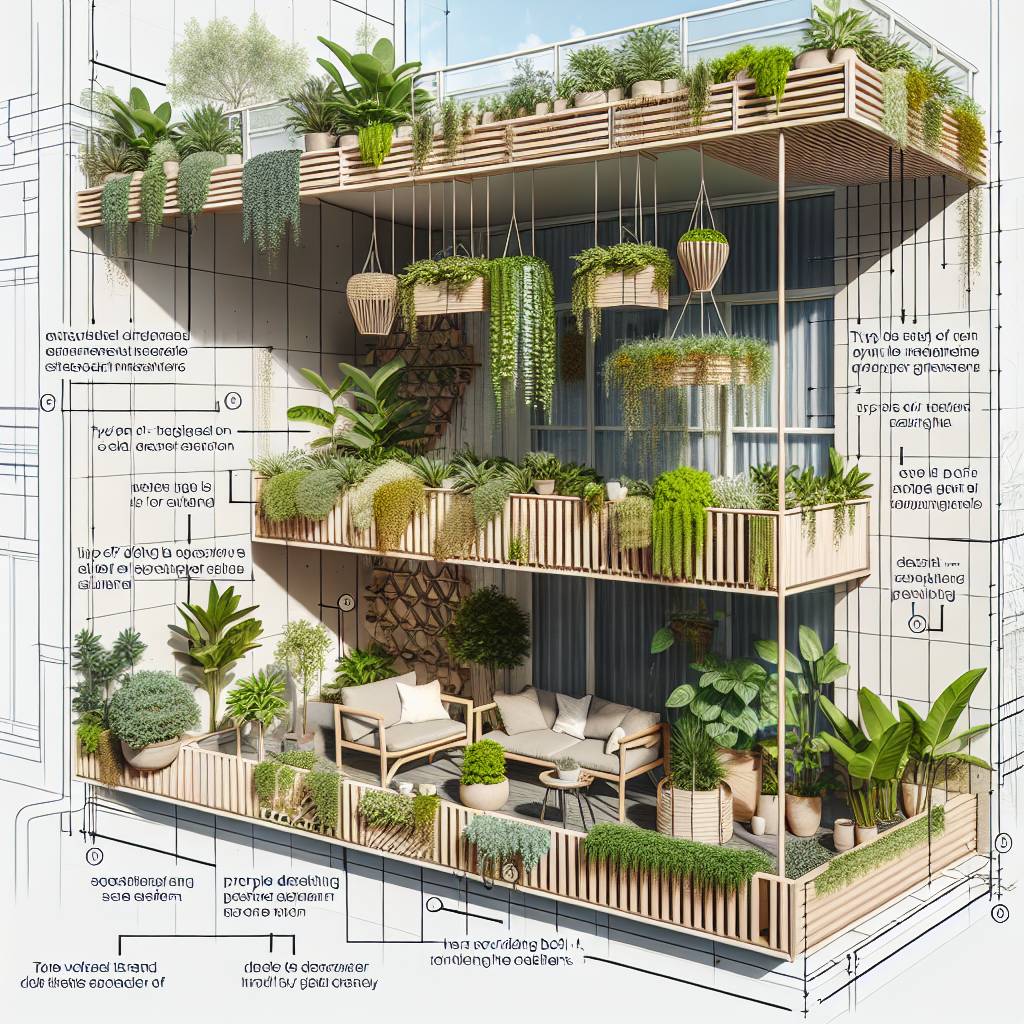Dreaming of a lush oasis on your balcony? Creating a thriving garden in this limited space requires thoughtful structural planning. How can you maximize every inch of living spaces, balcony space, and planter boxes without compromising aesthetics or safety? From weight restrictions to wind exposure, these factors play a pivotal role in designing a sustainable and visually appealing outdoor retreat.
Understanding load-bearing capacities, selecting suitable containers, waterproofing, lights, balcony space are paramount. Moreover, ensuring proper drainage and evaluating sunlight patterns are crucial for plant health. Join us as we unravel the key elements that underpin successful balcony gardens, guiding you towards transforming your urban outdoor space into an enchanting green haven.
Key Takeaways
- Assess balcony structure: Prioritize safety by evaluating your balcony’s strength and weight-bearing capacity before starting your garden.
- Strategic plant selection: Choose plants that thrive in your balcony’s specific microclimate, considering sunlight, shade, wind, and weather patterns.
- Effective waterproofing and drainage: Implement proper waterproofing and drainage solutions to prevent water damage and maintain the structural integrity of your balcony.
- Mindful container usage: Optimize space by creatively using containers while being mindful of weight limits to ensure the safety of your balcony.
- Regular maintenance is key: Commit to ongoing maintenance to ensure a healthy and thriving balcony garden, including watering, pruning, and monitoring for any structural issues.
- Maximize space with layout design: Design your balcony garden layout thoughtfully to make the most of the available space while considering aesthetic appeal and functionality.
Evaluating Your Balcony’s Structural Integrity
Evaluating Your Balcony’s Structural Integrity
It’s crucial to assess the structural integrity of your balcony. Start by checking for any cracks or signs of damage in the concrete or flooring. These can indicate potential weaknesses that may not be able to support the weight of large planters or containers.
Assess the strength and stability of the balcony railing. Make sure to use a sturdy enough material to handle additional weight from hanging plants or trellises. Look for any signs of water leakage or moisture damage, as these can weaken the structure over time and pose safety hazards.
It’s essential to ensure that your balcony can safely accommodate the weight and demands of a garden without compromising its structural integrity. By paying attention to these key building aspects and using them, you can create a safe and secure environment for your balcony garden.
Potential Risks and Precautions
While balconies offer an excellent space for gardening, there are potential risks associated with overloading them with heavy planters and containers. Overloading could lead to stress on the structure, causing cracks in concrete or weakening railings.
To prevent such risks, consider using lightweight materials for planters and containers whenever possible. Opting for compact soil mixtures instead of heavy ones will also reduce overall load on your balcony floor.
Regularly inspecting your balcony’s condition is vital in preventing unforeseen accidents due to wear-and-tear caused by environmental factors like rainwater seepage leading to rust formation on metal railings.
Designing Your Balcony Garden Layout
Consider the Space
When planning your balcony garden, it’s crucial to consider the available balcony space and its dimensions. Assess how much area you have for placing garden beds or planter boxes. This will help you determine the size and number of planters or garden beds that can fit comfortably on your balcony.
Think about the layout in terms of creating different zones for various activities. For instance, designate an area for seating where you can relax and enjoy your garden, while leaving ample space for walking around and accessing your plants.
It’s also essential to take into account any city regulations or building rules that might impact what you can place on your balcony. Some cities have specific guidelines regarding structural load limits and safety considerations for balconies, so be sure to check these before finalizing your design.
Plan Your Layout
Once you’ve evaluated the available space, start sketching out a rough plan for your balcony gardens. Consider where you want to place each element, such as seating areas, planters, trellises, or vertical gardening systems.
Think about how sunlight hits different parts of your balcony throughout the day. This will help you decide where to position sun-loving plants versus those that thrive in shade. By strategically placing taller plants at one end of the balcony and shorter ones at another, ensure all plants receive adequate sunlight without overshadowing each other.
Create a layout that allows easy movement around the space while providing convenient access to all areas of your garden. You don’t want to feel cramped when tending to your plants or moving from one part of the balcony to another.
Selecting Plants Based on Microclimate Considerations
Sunlight and Shade
The amount of sunlight your balcony receives is crucial. Some balconies may be sun-drenched, while others might be shaded throughout the day. It’s essential to choose plants that are well-suited to the specific light conditions of your balcony. For sunny balconies, consider sun-loving plants such as petunias, marigolds, or cherry tomatoes. On the other hand, if your balcony is mostly shaded, opt for shade-tolerant plants like ferns, begonias, or impatiens.
Balconies with a mix of sunlight and shade require a thoughtful selection of plants that can adapt to both conditions. For instance, hostas are known for thriving in partial shade and can add an elegant touch to such balconies.
Wind Exposure
In addition to sunlight considerations, wind exposure is another vital factor when choosing plants for your balcony garden. Windy microclimates can be challenging for many plants, leading to desiccation and damage. If your balcony experiences strong winds regularly, select sturdy plants that can withstand such conditions. Examples include ornamental grasses like feather reed grass or switchgrass which have flexible stems designed to sway with the wind rather than break.
Consider adding windbreaks like trellises with climbing vines or tall shrubs around the perimeter of your balcony garden space to provide protection from strong gusts.
Temperature Fluctuations and Humidity Levels
Temperature fluctuations and humidity levels also play a significant role in determining which plants will thrive on your balcony. Certain regions experience drastic temperature changes throughout the day or between seasons; therefore, it’s important to choose hardy plants capable of adapting to these variations.
For example:
- In areas with high humidity levels year-round (such as coastal regions), tropical plants like orchids or bromeliads are excellent choices.
- Conversely, succulents like echeverias or sedums are better suited for arid climates where humidity levels are low.
By considering all these microclimate factors — sunlight exposure, wind patterns, temperature variations, and humidity levels — you’ll be able to curate a diverse collection of plants that will thrive harmoniously within your unique urban oasis.
Waterproofing and Drainage Solutions
Applying Waterproof Sealant
To protect your balcony from water damage, it’s crucial to apply waterproof sealant. This helps create a barrier against moisture, preventing it from seeping into the balcony floor or walls. By doing this, you can safeguard the structural integrity of your balcony and prevent potential issues such as mold growth or concrete deterioration. For instance, using a high-quality waterproof sealant on the surface of your balcony can effectively repel water and extend its lifespan.
Installing Proper Drainage Systems
When setting up a balcony garden, it’s essential to install proper drainage systems to avoid water accumulation. Without adequate drainage, excess water can pool on the surface of the balcony, leading to potential hazards like slippery floors or damage to the underlying structure. One effective solution is incorporating sloped surfaces that direct water towards designated drainage points. Installing perforated pipes along with gravel layers can efficiently channel excess water away from the balcony area.
Raised Beds and Elevated Planters with Drainage Holes
Utilizing raised beds or elevated planters with drainage holes is an excellent strategy for managing excess water in your balcony garden. These raised containers not only provide better control over soil moisture but also help prevent issues related to overwatering or poor drainage. The presence of drainage holes allows any surplus water to escape freely from the containers, maintaining optimal growing conditions for plants while minimizing the risk of root rot due to stagnant moisture.
Understanding Weight Limits for Balcony Gardens
Consult Guidelines or Engineer
When planning a balcony garden, it’s crucial to consider the weight limits imposed by your building. Check your building’s guidelines or consult a structural engineer to determine the maximum load your balcony can support. This is essential for ensuring the safety and stability of your garden.
It’s important to calculate the combined weight of all elements that will be part of your balcony garden. These include the soil, plants, containers, and any additional furniture or decorations you plan to incorporate. By doing so, you can ensure that you stay within the permissible limits set by your building management or structural engineer.
Avoid Exceeding Limits
Exceeding weight limits on balconies can pose serious risks not only to the structure itself but also to those living in and around it. The potential consequences of surpassing these limits are far-reaching and may lead to structural damage or even collapse. Therefore, it’s imperative to avoid exceeding these weight restrictions at all costs.
One way to prevent going overboard with weight is by opting for lightweight materials when possible. For instance, choosing lightweight planters instead of heavy ceramic ones can significantly reduce the overall load on your balcony without compromising aesthetics.
Optimizing Space with Creative Container Usage
Utilize Vertical Space
Balconies often have limited room for traditional gardens. To maximize space, consider using hanging planters or installing trellises for climbing plants. These options allow you to make the most of the vertical area available, creating a visually appealing and functional garden without taking up valuable floor space.
Utilizing multi-tiered plant stands or shelves can help optimize your balcony garden. By stacking plants vertically, you can effectively increase the surface area for gardening while maintaining an organized and aesthetically pleasing display. This approach is particularly beneficial when dealing with small balconies or compact outdoor areas where every inch of space counts.
Repurposing everyday objects as unique plant containers is another clever way to optimize space in balcony gardens. For instance, old buckets or wooden crates can be transformed into charming and practical plant pots, adding an element of creativity and resourcefulness to your outdoor oasis.
Examples of Creative Container Usage
- Hanging succulent planters suspended from the ceiling.
- Installing a trellis system for growing vine vegetables such as tomatoes.
- Using multi-tiered metal plant stands to showcase a variety of potted herbs and flowers.
- Repurposing vintage teapots or tin cans as quirky yet functional plant containers.
Navigating Sunlight and Shade for Plant Health
Sunlight Requirements
Understanding the sunlight needs of your plants is crucial. Plants have varying light requirements, so it’s essential to place them accordingly. For sun-loving plants, ensure they receive at least 6 hours of direct sunlight daily. This can be achieved by positioning them on the south-facing side of your balcony where they can soak up as much sun as possible.
On the other hand, if your balcony doesn’t receive much sun, or if certain areas are shaded due to nearby buildings or structures, opt for shade-tolerant plants. These thrive in low-light conditions and are perfect for spaces with limited sunlight or high levels of shade. Consider using shade cloths or umbrellas strategically placed over these areas to protect the plants from intense sunlight while still allowing them to benefit from natural light.
Choosing the Right Plants
Selecting the appropriate plants based on their light requirements is vital for their growth and overall health. For instance, when planning your balcony garden, consider incorporating a mix of “thrillers,” “fillers,” and “spillers.” Thrillers are typically taller plants that add height and drama; fillers are medium-sized bushy plants that add fullness; spillers cascade over the edges of containers adding a softening effect.
To illustrate this concept further, let’s say you have a planter situated in an area that receives ample sunlight throughout the day – this would be an ideal location for thrillers like vibrant flowering vines or tall grasses that require abundant sunshine. Conversely, in an area with limited natural light where shade-tolerant varieties thrive best, you could plant ferns as fillers along with begonias serving as spillers which gracefully drape over the edges.
Wind and Weather Proofing Your Garden
Choosing Wind-Resistant Plants
Selecting the right plants is crucial. Opt for wind-resistant varieties such as ornamental grasses, lavender, or rosemary. These plants have sturdy stems and foliage that can withstand strong gusts without getting damaged. By choosing these resilient options, you ensure that your garden remains healthy and vibrant even in windy conditions.
Consider incorporating trailing plants like ivy or petunias into your garden. Their low-growing nature helps them stay close to the ground, reducing their exposure to harsh winds. This not only protects them from damage but also maintains a visually appealing garden despite windy weather.
Installing Windbreakers
To shield your balcony garden from harsh winds, installing windbreakers is essential. Consider adding trellises, screens, or glass panels around the perimeter of your balcony space. These structures act as barriers against strong gusts while still allowing sunlight to reach your plants.
Trellises are particularly effective for climbing plants like vines or jasmine which can use them for support while being protected from the wind at the same time. Screens provide a solid barrier against strong winds while also offering privacy and creating a cozy atmosphere on your balcony.
Glass panels serve a dual purpose by protecting your garden from wind and acting as transparent walls that allow sunlight through – an ideal solution if you’re dealing with both windy conditions and limited sunlight exposure on your balcony.
Securing Lightweight Planters and Garden Decor
In addition to choosing wind-resistant plants and installing windbreakers, securing lightweight planters and garden decor is vital in ensuring they don’t topple over during windy conditions. Consider using heavy terracotta pots instead of lighter plastic ones to anchor your plants firmly in place. Alternatively, secure lightweight pots by placing them inside heavier decorative containers or using discreet fastening systems designed specifically for balconies. For garden decor such as sculptures or hanging ornaments, ensure they are securely anchored using hooks or brackets attached directly to the wall cladding of your balcony.
Ongoing Maintenance for a Thriving Balcony Garden
Regular Care
To ensure your balcony garden thrives, it’s essential to provide regular care. This includes watering and fertilizing your plants according to their specific needs. Different plants have different watering requirements, so it’s crucial to understand the needs of each plant in your garden. Some may require daily watering, while others may only need water every few days. Similarly, fertilization should be tailored to the individual needs of each plant.
Regularly monitoring the soil moisture is vital in ensuring that your plants receive adequate hydration. You can do this by sticking your finger into the soil; if it feels dry about an inch below the surface, it’s time to water. Using a slow-release fertilizer or organic compost can help maintain healthy growth without overwhelming the plants with nutrients.
Pruning and Pest Control
In addition to regular watering and fertilization, pruning and trimming are essential tasks for maintaining a thriving balcony garden. Trimming back overgrown branches or dead leaves not only helps maintain the shape and appearance of your plants but also promotes healthy growth by allowing sunlight and air circulation to reach all parts of the plant.
Moreover, keeping an eye out for pests and diseases is crucial for preventing damage to your balcony garden. Aphids, spider mites, and whiteflies are common pests that can infest balcony gardens. Regularly inspecting both sides of leaves for any signs of infestation is important in catching problems early on before they escalate.
Applying natural remedies such as neem oil or insecticidal soap can effectively control pest populations without harming beneficial insects like bees or butterflies that visit your garden.
Summary
You’ve now got the lowdown on creating a flourishing balcony garden. By evaluating your balcony’s structure, designing a layout, selecting suitable plants, and considering microclimates, you’re well on your way to a green oasis. Waterproofing, weight limits, creative container usage, and weather-proofing will ensure your garden stands the test of time. Remember, ongoing maintenance is key to keeping your balcony garden thriving.
Now it’s time to roll up your sleeves and put these ideas into action. Get creative with your space, consider the unique conditions of your balcony, and start planning your green getaway. With these structural considerations in mind, you’re ready to turn your balcony into a vibrant and sustainable urban garden. Happy gardening!
Frequently Asked Questions
Is it safe to have a balcony garden in an old building?
Absolutely! However, before starting your balcony garden, it’s crucial to evaluate the structural integrity of your balcony. Consult with a professional to ensure that the structure can support the weight of plants and containers.
How do I choose the right plants for my balcony based on microclimate considerations?
Consider factors like sunlight exposure and wind patterns when selecting plants. For sunny balconies, opt for sun-loving plants like herbs and succulents. In shady areas, ferns and begonias thrive. Understanding your microclimate will help you make informed plant choices.
What are some creative ways to optimize space in a small balcony garden?
Maximize vertical space by using hanging baskets or wall-mounted planters. Consider utilizing multi-tiered shelves or railing planters to make the most of limited space while adding visual interest to your balcony garden.
How can I protect my balcony garden from harsh weather conditions?
To safeguard your plants from strong winds and extreme weather, install windbreaks such as trellises or mesh screens. Select sturdy containers that won’t easily topple over during storms and secure them properly.
What ongoing maintenance does a thriving balcony garden require?
Regular watering, pruning, fertilizing as needed, checking for pests/diseases are essential tasks for maintaining a healthy balcony garden. Keep an eye on soil moisture levels and regularly inspect plants for signs of stress or nutrient deficiencies.






